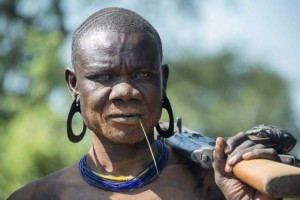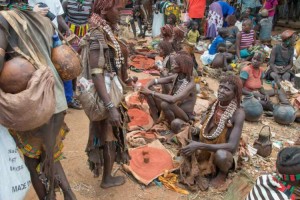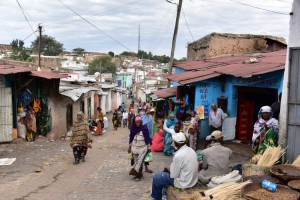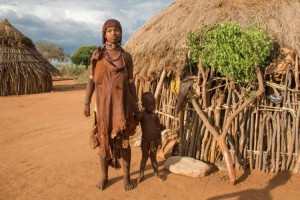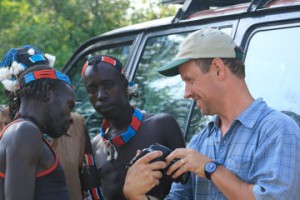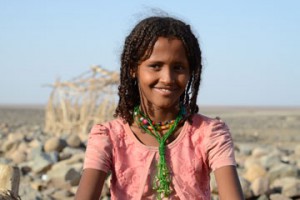Other People
Located in the remote south-west of Ethiopia Omo valley, As many as two dozen different tribes occupy this region, some numbering tens of thousands, other no more than 500, each one of them culturally unique. As The south Omo region is inhabited by colorful, culturally diverse tribes who continue their traditional lives, little changed by the outside world
Konso People
The dominant people of weita village on the Konso-Jinka road, are among the least known ethnic groups of Ethiopia. Estimated to tals some 5000 people, their territory extends along the western bank of the weita river, known in Tsemai as the dulaika river. They are mixed subsitence farmers who practise flood cultivation, with the major crops being sorghum and maize.
Although their appearance and dress style
The town Konso located at the entrance to the Omo Valley. The Konso people live in an isolated region of the basalt hills made up of hard rocky slopes. Konso village is fortified by a stone wall used for defensive measure. Their village is located on hilltops and is split up into communities, with each community having a main hut. In order to enter a Konso village, you must pass through a gate and a series of alleys. These paths are part of its security system makes the village difficult to access.
The erection of stones and poles is part of the Konso People tradition. A generation pole is raised every 18 years, marking the start of a new generation. The age of a village can be determined by how many poles are standing. Carved wooden statues are also used to mark the grave of a famous Konso tribal member. The marker, called a Waga is placed above the grave and smaller statues are then placed around the larger one representing his wives and conquered enemies.
As so often happened around the world, the women maintained the traditional ways. Konso women wore skirts that looked double layered. One ruffled skirt stopped at the hips. The second layer went to mid-calf. Favorite style was white cloth with a multi-colored trim. How the Konso women wore their blouses depended on the amount of work to be done, and the Konso people were hard workers! Many of the mountains in the region had been terraced. If the women weren’t working too hard, they wore their blouses the regular way. But, it they worked up a sweat carrying enormous loads on their backs, they frequently just pulled the blouse over their heads letting them (and anything else) hang down the front.
They are mixed agriculturists using their dry and infertile lands to grow crops. Animal dung is used to fertilize the land and most important crop is the sorghum, beans, cotton, corn and coffee. Sorghum is used as flour and to make local beer.
Face masks are worn at times and they have clay hair buns with feathers in them. Red clay mixed with butter is put into their hair and clothing is made from animal skin. The women scar their chest believing it makes them beautiful. The men’s scars represent an enemy or dangerous animal killed. They also wear clay hair buns which symbol a kill. A man in the tribe can have as many wives as he wants, but must be able to afford them. Most men will only marry two or three.
Bume
The Bumi or Bume people are also known as the Nyangatom. They live south of the Omo National Park, but occasionally move to the lower regions if food or water is scarce. Known to be fierce fighters, they are often at war with Hamer and Karo tribes. Different from other tribes, the Bumi tribesmen hunt crocodiles using harpoons and a canoe.
Scarification is practiced by both men and women in the tribe. The women do it to beautify themselves and the men to signify a kill. Both sexes wear a lot of multi colored necklaces and may also have a lower lip plug. The tribe practices both agriculture and cattle herding. Flood waters must recede along the river’s banks before they will plant their crops. Beehives are smoked out by the Bumi and they gorge themselves with the honey.
Dorze People
Well known as cotton weavers and their cotton woven cloths and beehive shaped dwellings were made from woven bamboo and thatch from bamboo leaves huts. The Dorze people live in large communities north of Addis Ababa. They cultivate their own food and prevent erosion by terracing along the mountainside. In their farmlands, the Dorze will grow highland cereals. They also grow spices, vegetables, fruits and tobacco within their compound.
Women of the Dorze tribe have most of the responsibility in the family. They must take care of any children and all of the house choirs. The women are also responsible for cooking, spinning cotton and collecting firewood. Male tribal members spend most of their time on the farm or building huts. Sometimes you will find them weaving material to use for different things. The Dorze people wear colorful toga robes called shammas. They are very popular throughout Ethiopia.
A Dorze hut made from hard wood poles, woven bamboo, enset (False banana leaves) and other natural materials. It can stand two stories tall and last up to 80 years. Inside the main hut, you will find a fire place, a seating area and bedrooms. Smaller huts can include guest houses, a workshop, a kitchen and even cattle shed. When termites attack the hut, the Dorze can just remove it from its foundation and relocate it. This allows the home to last much longer, but every move shortens the height of the hut.
In the far west in Gambella, along the Baro river is being found the Anuak, Nuer and Misingir people.
The Anuak people live in villages along the river banks of the lowlands of Gambela and both the Anuak and Nuer people are distinguished from other Ethiopians by their height and very dark skin. In terms of decoration, both groups wear wood or shell and horn necklaces but the Nuer alone receive facial scarrings as part of their initiation into adulthood. Both groups still harvest fish from the river Baro using spears but the Nuer are primarily cattle herders and are more gregarious than the Anuak. The Oromoes, numerically the biggest tribe in the country dominates most of the settlements in the west, they are mixed farmers and they live in very fertile and scenically attractive land. There are some remarkable and colourful weekly markets in the Oromo region which gets the interest of tourists.
Our company now offers a newly designed tour to this region, which is mainly about discovering the origin of coffee and other coffee growing areas in Ethiopia combined with cultural tours and photo safaris. For more information visit our sample tour programs in the itinerary page. Gambella can be reached by air, or by a 2 days road trip.
Kwegu or Muguji
The kwegu or Muguji are one of the smallest tribes in Omo Valley, living in small villages along the Mago River. Unlike the other tribes, the Kwegu do not have cattle. They are hunters and live off the land. Small game is trapped by the tribe for food, but they also eat fruits and honey if available. They are largleydependant on the Omo River for fish to eat. Close relatives to the Kwegu are the Karo people. It is often that you can find Kwegu and Karo people living together or even marrying each other.
Tsemai
Also spelled Tsemai, they are found living in the semi-arid region of the Omo Valley. These people are agro-pastoralist and use both livestock herding and agriculture to survive. Common crops grown by the tribe are sorghum, millet and sometimes cotton.
Like the Hamer tribe, the Tsemay boys have to successfully complete a bull jumping event. This is a ceremony where the boy runs across multiple bulls. If the boy can make it across four times without falling, he becomes a man. To prove a boy has accomplished a bull jumping, he is outfitted with a band that has feathers on it. It is worn on his head and it shows that he is now looking for a wife.
Unlike any other tribe in Ethiopia, the Tsemay have arranged weddings. The parents of the woman pick who she will marry with or without her consent. Even if the marriage is arranged, the man must still be able to afford to pay for his future wife. Payment of cattle, honey, grain and coffee beans are accepted. Women of the tribe, who are not married, wear a short leather skirt with a v-shaped apron attached. Married women wear long leather dresses with an apron that have an apron covering their front and back side. The men in the tribe are found carrying small wooden seats to sit with.
Turkana People
The second largest pastoral tribe in Kenya, the Turkana is nomadic (move from place to place). They live in northern Kenya around Lake Turkana. In 1975 the lake was named after them. Their land is mostly dry desert regions and they depend on the rainy seasons for survival. Because water is so scarce in the area, they often fight with other tribes over territory. They are known to be very aggressive and dangerous. Traditional beliefs of the Turkana have hardly been affected by western civilization. The Turkana pray to Akuj for rain during the dry season. Akuj is their god and they will make animal sacrifices hoping to please it.
Like most indigenous people, cattle are precious to them. The cows provide them with food and a higher status. Other animals such as, camels, donkeys, goats and sheep are kept by them. Being nomadic people, they are constantly searching for better land and more water. Very colorful people, they dress themselves up with necklaces and bracelets. Decorations are made with brown, red and yellow colors. Men cover their heads with mud and paint it blue with feathers. They tattoo their bodies to show that they have killed an enemy. with brown, red and yellow colors. Men cover their heads with mud and paint it blue with feathers. They tattoo their bodies to show that they have killed an enemy.
Something different from the other tribes in Africa, the Turkana do not allow circumcision among its people. Women are only considered adults after they are married and men can marry as many wives as he can afford. In the Turkana tribe, a married woman will wear different type of jewellery.
AFAR PEOPLE
AFAR PEOPLE the proud nomadic shepherds, reside in the Danakil Desert in Ethiopia Afar Region, as well as in Eritrea and Djibouti. They speak the Afar Language as a mother tongue part of the Cushitic branch of the Afro-Asiatic language family.
Traditionally, the society is ruled by sultanates made up of several villages headed by a dardar. Afar are organized into clan families, and into classes — asaimara (‘reds’) who are the dominant class politically, and the adoimara (‘whites’) who are a working class. They practice circumcision for both. A boy is judged for his bravery upon bearing the pain of circumcision, and is then allowed to marry the girl of his choice, though preferably someone from his own ethnic group.
The Afar People have a strong relationship with their environment and its wildlife, sharing land and resources with animals and doing them no harm. It is this tendency that is largely responsible for the preservation of the critically endangered African wild ass (Equusafricanus)(, which has become extinct in more vulnerable environments.
Afar Danakil Depression (The Afar Depression), a plate tectonic triple junction is found in the Afar Regional state. This geologic feature is one of earth’s great active volcanic areas. Due to this volcanic activity the floor of the depression is composed of lava, mostly basalt. The continuous process of volcanism results in the occurrence of major minerals including potash, sulfur, salt and gypsum. In addition to these minerals, there are also promising geothermal energy sources and hot springs in different areas of the region. Most of the region’s mineral potential are found in Dallol, Brhale and Afdera woredasof Zone.
Afar Region is the site where “LUCY”, the Australopithecus Afarensis skeletal remains at Hadar and other many hominid species were discovered and 120 meters below sea level at the sulfuric inferno Danakil depression and with its glittering volcanic scene of Er’tale.

